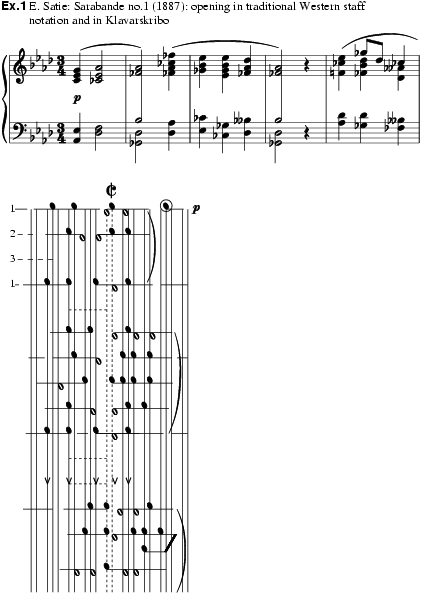
(from Esperanto klavar: ‘keyboard’, skribo: ‘writing’).
A system of notation developed in the Netherlands, in about 1930, by Cornelis Pot (1885–1977). In 1931 a publishing house was set up in Slikkerveer (south of Rotterdam) for the publication of editions in the new notation system. It continues to publish and print music in Klavarskribo, and has also become a teaching institute. In 1990 the total number of its publications was 15,000, an output that includes a large proportion of the standard repertory for piano and organ, as well as a number of works for voice, for string and wind instruments, and theory publications. The notation system has attained a certain popularity in the Netherlands and is also used in other countries.
The system is based on a vertical staff in which groups of two thin and three thicker lines are shown in the same arrangement as the black keys on a keyboard (see ex.1). Each octave has its own staff of five lines, providing space for seven white-note symbols in between the lines and five black-note symbols on the lines. Note stems are shown as horizontal lines, the direction of the stem indicating (for keyboard music) which hand plays a note or group of notes or (for other instrumentations) which notes belong to which voice or part. A C clef is used to indicate middle C (c'), the two lines next to this note usually being printed as dotted lines as a further means of orientation. The number of octaves per staff can be increased as necessary. Accidentals are not necessary because the white notes are printed as open, or void, notes and the black notes as filled notes; each note has its own place on the staff, and enharmonic differences of tonal function are not generally shown in the notation. The key of a composition is indicated at the beginning or during the course of the piece by means of the tonic, which is marked surrounded by a circle (major) or a rhomboid shape (minor).

The notation is represented as moving down the staff. All the bars of a piece are the same size and are divided into a number of equally-sized beats, depending on the time signature. The first beat of a bar is printed on a solid line and subsequent beats are represented by broken lines; notes on the half-beat are printed halfway between the beat-lines (and smaller note values are similarly spatially represented). The duration of the notes is generally indicated by the distance between notes with the same stem direction (i.e. not by the shape of the note heads). There are two exceptions to this: a rest is indicated by a stop sign printed where the note is to stop sounding; and a continuation dot indicates where a note is to continue beyond the onset of the next note. Performance indications are the same as in the traditional Western staff notation system.
Klavarskribo is primarily intended as a universal music (sound) notation for all instruments and voice. Because of its representation of the piano keyboard it functions as a kind of tablature for that instrument. There are special chord notations for specific instruments (such as the guitar and accordion). (For a further illustration see Notation, fig.79.)
WILKE JAN KAASJAGER